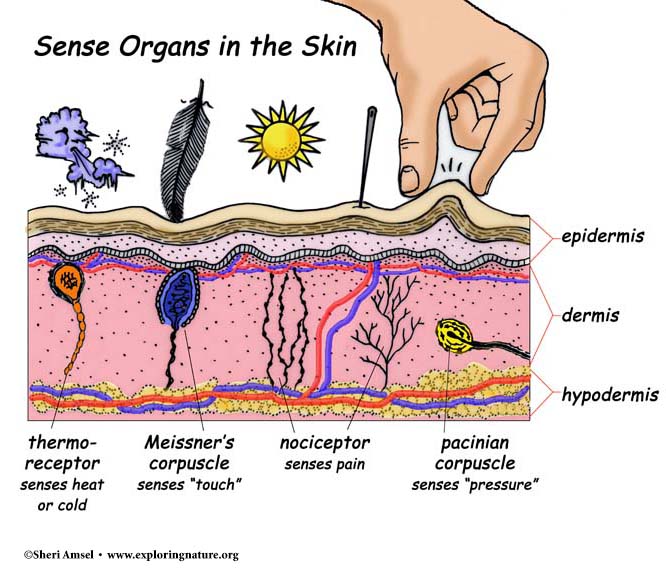

A more general special sense is that of touch, which you can feel all over the body on the skin. Your skin, which is also called integument or epithelium, is considered the largest organ of the body, making up about 7% of your body weight. That means that a 200-pound adult has about 3,000 square inches of skin, which weighs about 14 pounds.
Touch stimuli is picked up by cutaneous sensory receptors in the skin. These little nerve endings pick up stimuli from the outside world, such as heat, cold, pressure and pain.
There are many kinds of receptors. Meissner’s corpuscles are egg-shaped receptors found just below the top layer of the skin in the epidermis. They pick up light touch. These receptors help us identify objects by touch. Close your eyes and have someone place an object in your hand, feel it with your fingers until you know what it is. This is the Meissner’s corpuscles at work.
Deep in the skin, in the dermis, Pacinian corpuscles feel deep pressure, like a painful squeeze.
Free nerve endings sit just below the top layer of the skin in the epidermis. They pick up heat, cold or pain. The receptors that pick up heat and cold are called thermoreceptors. The receptors that pick up pain are called nociceptors.
For more detailed content see the Integumentary System.
When you research information you must cite the reference. Citing for websites is different from citing from books, magazines and periodicals. The style of citing shown here is from the MLA Style Citations (Modern Language Association).
When citing a WEBSITE the general format is as follows.
Author Last Name, First Name(s). "Title: Subtitle of Part of Web Page, if appropriate." Title: Subtitle: Section of Page if appropriate. Sponsoring/Publishing Agency, If Given. Additional significant descriptive information. Date of Electronic Publication or other Date, such as Last Updated. Day Month Year of access < URL >.
Amsel, Sheri. "Touch and the Sensory Receptors of the Skin" Exploring Nature Educational Resource ©2005-2024. December 13, 2024
< http://www.exploringnature.org/db/view/Touch-and-the-Sensory-Receptors-of-the-Skin >
